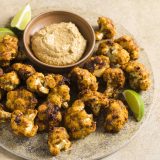Eduardo García is adamant: If you want great cauliflower, treat it as you would a fine steak.
All too often, “when we eat cauliflower, we eat it overcooked,” laments García, chef-owner of Mexico City restaurant Maximo Bistrot. His approach? Season the vegetable with a rub, much as you would meat, then cook it only until rare. Finally, serve it with a bold sauce.
García puts this philosophy into play in his book, “Maximo,” where his richly seasoned cauliflower begins with a paste made from chilies, Marcona almonds and tomatoes that have been dehydrated to concentrate their sugars. That blend is slathered onto big, meaty wedges of cauliflower that he oven-roasts just long enough for the edges of the florets to scorch while the insides remain toothsome. To finish, he spoons on a fresh, bright serrano chili-spiked cilantro salsa.
But as with steak, the key is starting with quality ingredients. “You have to have a crisp cauliflower for this dish,” he says.
It’s just one of the many ways that García puts vegetables in the spotlight. And the bounty of Mexico’s agriculture gives him plenty to work with: “It makes me happy that we live in one of the largest cities in the world, but 25 minutes out, it’s full of farms and full of green,” he says.
In fact, Maximo’s supply of herbs is grown right in Mexico City itself, harvested from the famed “floating gardens” of Xochimilco. Located on the outskirts of the city, this network of canals studded with artificial islands (called chinampas) has been used for agriculture since the days of the Aztecs. “It’s mind-blowing that you can put yourself in a place where, a thousand years ago, people were growing crops,” he says. “It’s super romantic for a chef.”
While García’s ingredients are local, his cauliflower recipe reveals broader influences. His travels through the Mediterranean inspired him to combine the concentrated tomato zing of a Spanish romesco sauce with the chili pepper heat of Moroccan harissa, balanced by deeply savory Spanish Marcona almonds. All of which he melds with Mexican flavors—the cilantro salsa with toasted pumpkin seeds, for example.
We loved the way García elevates his vegetables with layers of flavor. Our version of his cauliflower stays mostly true to his recipe, with a few simplifications. Instead of a separate spice paste and salsa, we opted to puree the cilantro, sun-dried tomatoes, almonds, pumpkin seeds and jalapeños with olive oil. We then use that mixture to season the cauliflower florets as they roast in the oven; the rest we transform into a sauce to serve alongside the finished dish.






